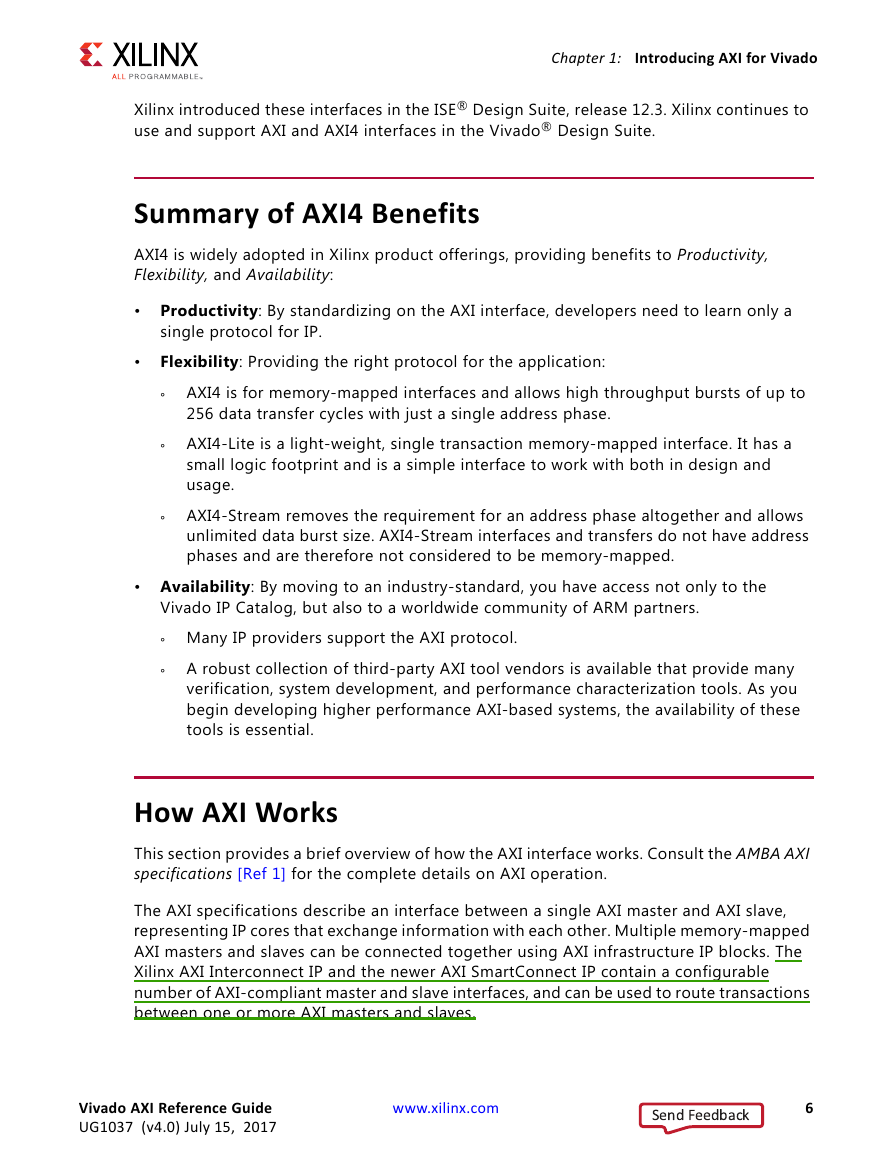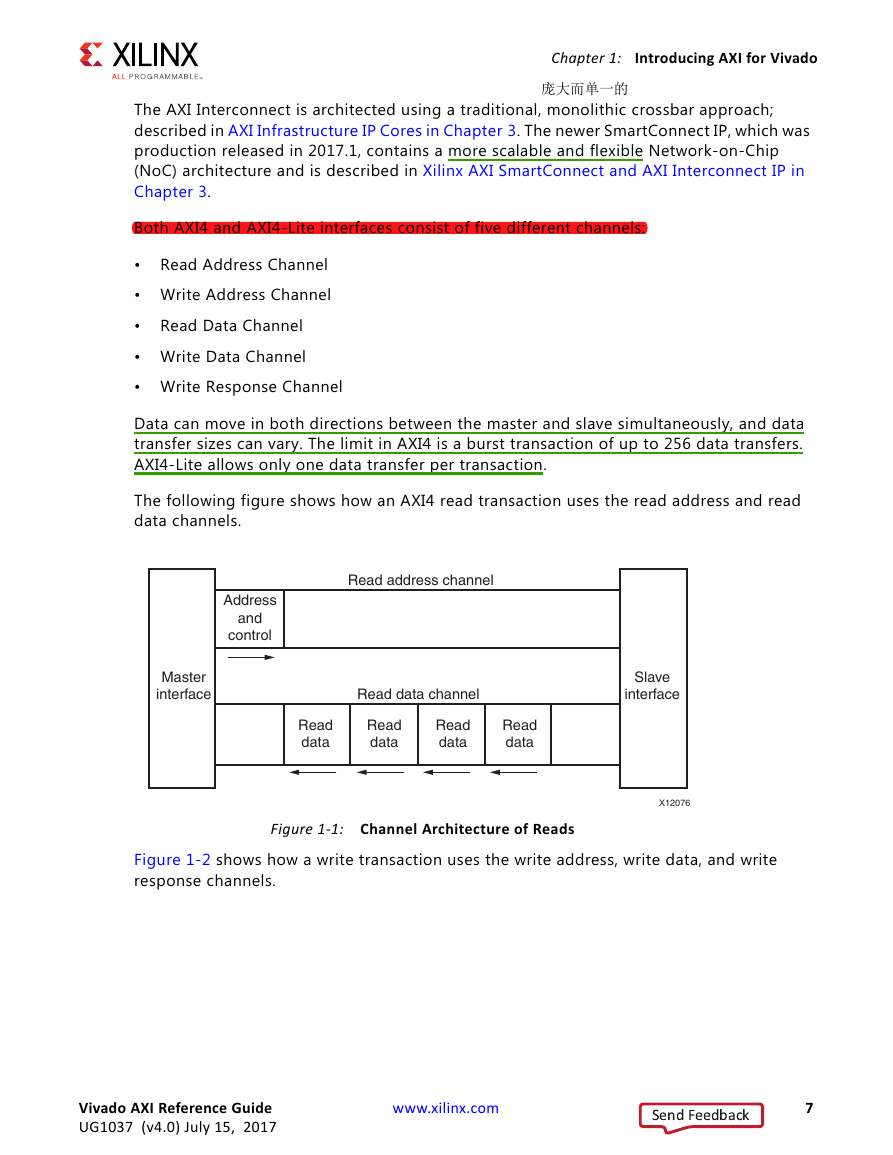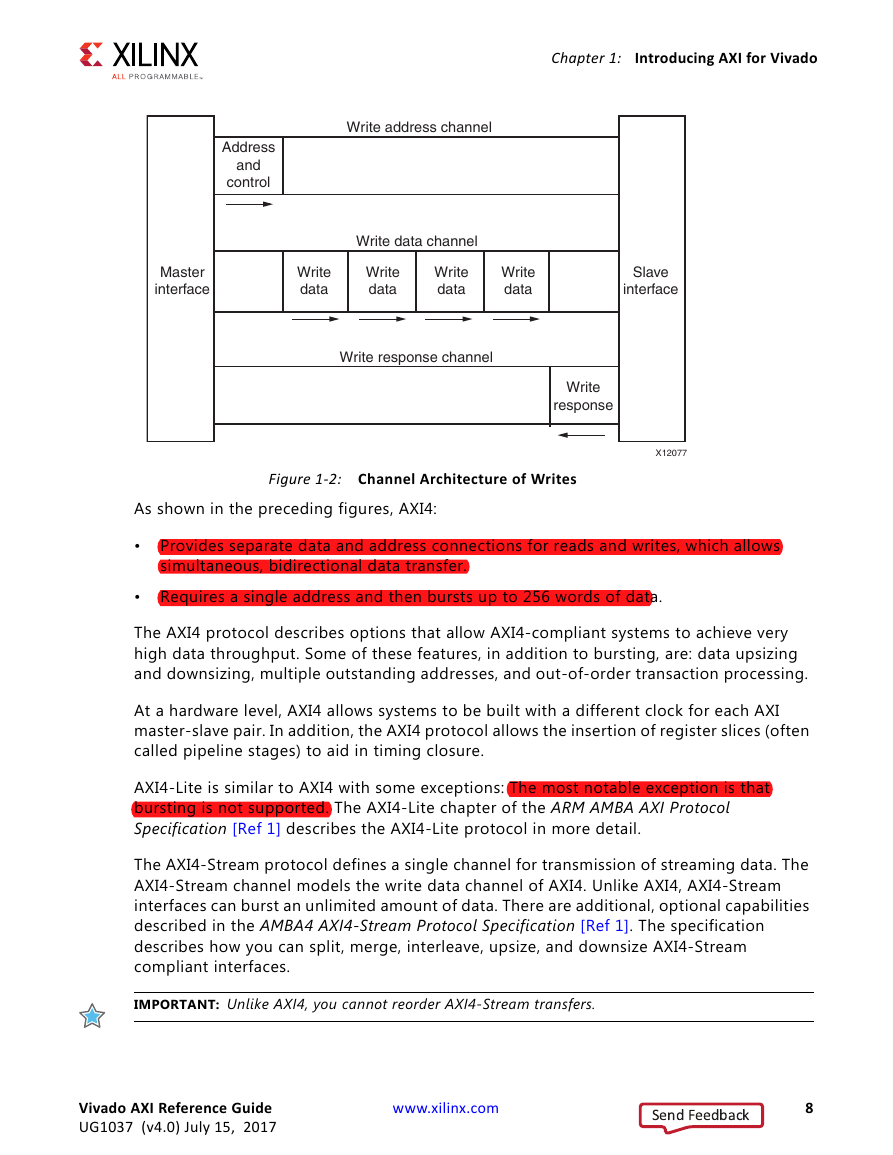Vivado Design Suite: AXI Reference Guide
Revision History
Table of Contents
Ch. 1: Introducing AXI for Vivado
Overview
What is AXI?
Summary of AXI4 Benefits
How AXI Works
Combining AXI4-Stream and Memory-Mapped Protocols
IP Interoperability
Data Interpretation
IP Compatibility
AXI4-Stream IP Interoperability
Quick Take Videos
Ch. 2: AXI Support in Xilinx Tools and IP
Introduction
Using Vivado AXI IP in RTL Projects
Using the Create and Package IP Wizard for AXI IP
Adding AXI IP to the IP Catalog Using Vivado IP Packager
Using Vivado IP Integrator to Assemble AXI IP
Using AXI IP in System Generator for DSP
Port Name Truncation
Port Groupings
Breaking Out Multichannel TDATA
Adding AXI Interfaces Using High Level Synthesis
HLS AXI4-Stream Interface
HLS AXI4-Lite Interface
HLS AXI4 Master Interface
Individual Data Transfers
Example 1:
Example 2:
Burst-Mode Transfers
Ch. 3: Samples of Vivado AXI IP and Xilinx Processors
Overview
AXI Infrastructure IP Cores
Xilinx AXI SmartConnect and AXI Interconnect IP
AXI Interconnect Core Features
AXI Interconnect Core Limitations
AXI Interconnect Core Use Models
Conversion Only
N-to-1 Interconnect
1-to-N Interconnect
N-to-M Interconnect (Sparse Crossbar Mode)
Cascading AXI Interconnect Cores Together
AXI SmartConnect IP
Feature Summary
AXI SmartConnect Core Limitations
AXI4-Stream Interconnect Core IP
AXI4-Stream Interconnect Core Features
AXI4-Stream Interconnect Core Diagram
AXI4-Stream Interconnect Core Use Models
Streaming Data Routing and Switching (Crossbar Mode)
Stream Multiplexing and De-multiplexing
AXI Virtual FIFO Controller
The AXI4-Stream interconnect can also perform local FIFO buffering, clock conversion, and width conversion to adapt the interface of the stream endpoints to the data path of the virtual FIFO controller and the AXI memory controller
DataMover
AXI4 DMA
AXI DMA Interfaces
Central DMA
AXI Central DMA Summary
AXI Central DMA Scatter Gather Feature
Central DMA Configurable Features
Video DMA
AXI VDMA Summary
VDMA AXI4 Interfaces
Simulating IP
Using Debug and IP
ILA
VIO
IBERT
JTAG-to-AXI
Performance Monitor IP
Protocol Checkers
AXI Verification IP
Features
Uses
AXI4-Stream Verification IP
Features
Overview
Zynq-7000 AP SoC Verification IP
Features
Additional Features
Limitations
MicroBlaze Debug Module
Zynq UltraScale+ MPSoC Processor Device
PS-PL AXI Interfaces
Zynq-7000 All Programmable SoC Processor IP
Choosing a Programmable Logic Interface
PL Interface Comparison Summary
Cortex-A9 CPU Using General Purpose Masters
PS DMA Controller (DMAC) Using General Purpose Masters
PL DMA Using AXI High-Performance (HP) Interface
PL DMA Using AXI ACP
PL DMA Using General Purpose AXI Slave (GP)
Memory Management Unit (MMU)
MicroBlaze Processor
Overview
MicroBlaze Features
Configurable MicroBlaze Feature Overview
MicroBlaze Memory Architecture
MicroBlaze Hardware AXI Exceptions
Using MicroBlaze AXI Instruction Cache
Using MicroBlaze AXI Data Cache
Using Victim Cache
MicroBlaze Stream Link Interfaces
Ch. 4: AXI Feature Adoption in Xilinx Devices
Introduction
Memory-Mapped IP Feature Adoption and Support
AXI4-Stream Adoption and Support
AXI4-Stream Signals
Numerical Data in an AXI4-Stream
Real Scalar Data Example
Complex Scalar Data Example
Vector Data Example
Sideband Signals
Events
TLAST Events
DSP and Wireless IP: AXI Feature Adoption
Video IP: AXI Feature Adoption
IP Using AXI4-Stream Video Protocol
Signal Interfaces
Input Slave Side Connectors
Output Master Side Signals
Clocking and ACLK
TDATA Structure
Clock Enable, ACLKEN
Reset Requirements, ARESETn
TKEEP and TSTRB
TID
TDEST
TUSER
Signaling Protocol
Channel Structure
READY/VALID Handshake
Guidelines on Driving VALID
Driving READY Guidelines
Interfacing to AXI4-Stream With No READY Signal
Start of Frame Signal - SOF
End Of Line Signal - EOL
Real Time Requirements
Data Format
AXI4-Stream Specific Parameterization
Encoding
Encoding Multiple Pixels
Dynamic TDATA Configuration
Ch. 5: Migrating to Xilinx AXI Protocols
Introduction
Migrating to AXI for IP Cores
Migrating IP Using the Vivado Create and Package Wizard
Using System Generator for DSP for Migrating IP
Migrating a Fast Simplex Link to AXI4-Stream
Master FSL to AXI4-Stream Signal Mapping
Slave FSL to AXI4-Stream Signal Mapping
Differences in Throttling
Migrating HDL Designs to use DSP IP with AXI4-Stream
DSP IP-Specific Migration Instructions
Demonstration Test Bench
Upgrading IP
Latency Changes
Mapping Previously Assigned Ports to An AXI4-Stream Video Protocol
High End Verification Solutions
Ch. 6: AXI System Optimization: Tips and Hints
Introduction
AXI System Optimization
Size/Area Optimization Guidelines
Timing and Fmax Optimization Guidelines
Throughput and Bandwidth Optimization Guidelines
Latency Optimization Guidelines
Ease of Use and Debug Optimization Guidelines
AXI4-based Vivado Multi-Ported Memory Controller: AXI4 System Optimization Example
AXI4 Vivado MPMC Overview
Initial Memory Controller Configuration
Initial AXI Interconnect Configuration
Clock Conversion Recommendation
AXI4 Master Configuration
Maximize Burst Length
No Narrow Burst Transactions
Pipeline Transactions
Single Thread Transactions
Refining the AXI Interconnect Configuration
Independently Configure Converter Banks
Timing Considerations
Setting Issuance and Acceptance Values to 2 or Higher
Adding a Processor to the AXI MPMC System
Considerations When Adding a Processor
Additional Potential Optimizations for AXI MPMC
AXI Interconnect: Shared Address Shared Data Mode
Separate IP Groups into Separate AXI Interconnect Subsystems
Debug and Analysis: Using AXI Debug Monitor and AXI Hardware Protocol Checkers
Floorplanning
AXI Verification IP
More Simple but Wider Interconnect and Memory Controller
Cascading Interconnects
Common Pitfalls Leading to AXI Systems of Poor Quality Results
Oversizing a Memory Controller
Incorrect Core Data Width or Core Clock for AXI Interconnect
Overuse of Register Slices
Skipping Simulation-Based Verification of New IP
Non-contiguous Mapping of Slave Devices in Cascaded Interconnect Scenarios
Optimizing AXI on Zynq-7000 AP SoC Processors
Considerations for High Performance AXI Interface Modules
Ch. 7: AXI4-Stream IP Interoperability: Tips and Hints
Introduction
Key Considerations
AXI4-Stream Protocol
Domain Usage Guidelines and Conventions
Video IP
DSP/Wireless IP
Communications IP
AXI Infrastructure IP
Domain-Specific Data Interpretation and Interoperability Guidelines
Video IP Layered Protocols
DSP/Wireless IP Layered Protocols
Communications IP Layered Protocols
AXI Infrastructure IP Layered Protocols
Appx. A: AXI Adoption Summary
Introduction
Global Signals
AXI4 and AXI4-Lite Signals
AXI4 and AXI4-Lite Write Address Channel Signals
AXI4 and AXI4-Lite Write Data Channel Signals
AXI4 and AXI4-Lite Write Response Channel Signals
AXI4 and AXI4-Lite Read Address Channel Signals
AXI4 and AXI4-Lite Read Data Channel Signals
AXI4-Stream Signal Summary
Appx. B: AXI Terminology
Terminology
Appx. C: Additional Resources and Legal Notices
Xilinx Resources
Solution Centers
Documentation Navigator and Design Hubs
Third-Party Documentation
Xilinx Documentation
Xilinx White Papers and Application Notes
General Xilinx References
Vivado Design Suite Video Tutorials
Please Read: Important Legal Notices
















 2023年江西萍乡中考道德与法治真题及答案.doc
2023年江西萍乡中考道德与法治真题及答案.doc 2012年重庆南川中考生物真题及答案.doc
2012年重庆南川中考生物真题及答案.doc 2013年江西师范大学地理学综合及文艺理论基础考研真题.doc
2013年江西师范大学地理学综合及文艺理论基础考研真题.doc 2020年四川甘孜小升初语文真题及答案I卷.doc
2020年四川甘孜小升初语文真题及答案I卷.doc 2020年注册岩土工程师专业基础考试真题及答案.doc
2020年注册岩土工程师专业基础考试真题及答案.doc 2023-2024学年福建省厦门市九年级上学期数学月考试题及答案.doc
2023-2024学年福建省厦门市九年级上学期数学月考试题及答案.doc 2021-2022学年辽宁省沈阳市大东区九年级上学期语文期末试题及答案.doc
2021-2022学年辽宁省沈阳市大东区九年级上学期语文期末试题及答案.doc 2022-2023学年北京东城区初三第一学期物理期末试卷及答案.doc
2022-2023学年北京东城区初三第一学期物理期末试卷及答案.doc 2018上半年江西教师资格初中地理学科知识与教学能力真题及答案.doc
2018上半年江西教师资格初中地理学科知识与教学能力真题及答案.doc 2012年河北国家公务员申论考试真题及答案-省级.doc
2012年河北国家公务员申论考试真题及答案-省级.doc 2020-2021学年江苏省扬州市江都区邵樊片九年级上学期数学第一次质量检测试题及答案.doc
2020-2021学年江苏省扬州市江都区邵樊片九年级上学期数学第一次质量检测试题及答案.doc 2022下半年黑龙江教师资格证中学综合素质真题及答案.doc
2022下半年黑龙江教师资格证中学综合素质真题及答案.doc